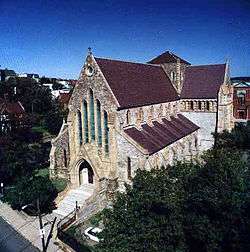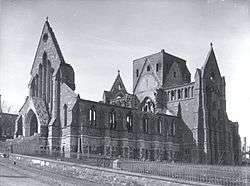Cathedral of St. John the Baptist (St. John's)
| Cathedral of St. John the Baptist | |
|---|---|
 | |
| Denomination | Anglican |
| Website | StJohnsAnglicanCathedral.org |
| History | |
| Dedication | John the Baptist |
| Administration | |
| Diocese | Eastern Newfoundland and Labrador |
| Clergy | |
| Bishop(s) | Geoffrey Peddle |
| Dean | Josiah Noel |
| Curate(s) | Paul Rideout |
| Laity | |
| Organist/Director of music |
Sharon Whalen (interim) |
| Official name | St. John the Baptist Anglican Cathedral National Historic Site of Canada |
| Designated | 1979 |
The Cathedral of St. John the Baptist is located in the city of St. John's, Newfoundland and Labrador, Canada. This parish in the Diocese of Eastern Newfoundland and Labrador was founded in 1699 in response to a petition drafted by the Anglican townsfolk of St. John's and sent to Henry Compton, Bishop of London. In this petition, the people also requested help in the rebuilding of their church, which had been destroyed, along with the rest of the city, in 1696 by the French under the command of Pierre Le Moyne d'Iberville. At least six wooden churches stood on or near this site and were destroyed by military operations during the wars between the French and the British which finally resulted in British control of North America.
History
The first stone church was begun in 1843 under the direction of Aubrey Spencer, the first Bishop of Newfoundland, but little progress was made on this relatively modest edifice beyond the laying of a cornerstone before Spencer resigned due to ill health.

The present cathedral was begun in 1847 by Edward Feild, the second Bishop of Newfoundland. Feild commissioned plans from a leading Gothic Revival architect, George Gilbert Scott, who envisioned a more impressive cruciform structure with varied ornamentation in the 12th century English style. The nave, built between 1847 and 1850, served as the entire cathedral church for 35 years. Scott's assistant, architect William Hay, oversaw the nave's construction.[1]
Construction on the choir and transept section did not commence until 1880 and was completed in September 1885, under the direction of James Butler Knill Kelly. The additions to the nave gave the cathedral the shape of a Latin cross and continued the era of Gothic Revival architecture in the construction of nineteenth-century Anglican churches in Newfoundland.

On July 8, 1892, the Cathedral was extensively damaged in The Great Fire of 1892. The roof timbers ignited, which caused the roof to collapse, bringing the clerestory walls and piers in the nave down with it. The intense heat caused the lead to melt in the glass windows, resulting in the complete destruction of all but two; the sole surviving window can be seen in the Sacristy. Restoration of the Cathedral commenced in 1893, again under Kelly's direction. By 1895, the Chancel and Transepts had been rebuilt, while the Nave reached completion in 1905. A window in the restored Cathedral was dedicated to Kelly, who died in 1907. The Te Deum Window was donated in 1952 in memory of Bermudian-born Sir Joseph Outerbridge by his family.[2][3]
The restored cathedral is renowned internationally as one of North America's best ecclesiastical Gothic Revival structures. The church was re-consecrated in a service on September 21, 1905.
The Cathedral remains incomplete as the structure still lacks the spire which its designer, Scott, had envisaged. Although an engineering team has established that the proposed 150-foot (46 m) tower and steeple is structurally feasible, the cost was estimated to be $3,000,000. The clergy and parishioners remain committed to completing Scott's plans and are hopeful that they will see the spire erected.
Dimensions

The Cathedral stretches 200 feet (61 m) from the Great West Doors to the Sanctuary, with a 60-foot (18 m) wide nave and a maximum width of 99 feet (30 m) at the transepts. Where nave and transept cross, the floor-to-ceiling height is 57 feet (17 m); outside, the roof stands 80 feet (24 m) high at the ridge.
Worship
The Cathedral offers Holy Communion on a daily basis. Services are held most frequently on Sundays, at 7:30 am, 8:00 am, 9:15 am, 11:00 am, and 4:00 pm.
Heritage designations
The cathedral was designated a National Historic Site of Canada in 1979 as a nationally significant example of Gothic Revival architecture.[4] The building was also designated as a Registered Heritage Structure by the Heritage Foundation of Newfoundland and Labrador in 1991,[5] and a City of St. John's Heritage Building in 1989.[6]
See also
References
- ↑ "Church of England Cathedral, Saint John's, Newfoundland." Vol. 3, No. 13 Canada Farmer (Toronto) (April 1, 1871), p. 204.
- ↑ Passing of Sir Joseph Outerbridge, Kt.. The Western Star, Newfoundland. 18 October 1933.
- ↑ A Brief History of the Cathedral and the Parish of St. John the Baptist. 'The source for the document was the Cathedral’s former website, which credits Dr. Stephanie Kennell and Mrs. Julia Mathieson. The former website was developed by the Rev’d Roger Whalen, and later maintained by Mr. Andrew Reid. Copied with minor modifications 11 October, 2008 by Dr. David Tulett, and revised 2 February 2009.'
- ↑ St. John the Baptist Anglican Cathedral National Historic Site of Canada. Canadian Register of Historic Places. Retrieved 14 July 2012.
- ↑ Anglican Cathedral of St. John The Baptist Registered Heritage Structure. Canadian Register of Historic Places. Retrieved 14 July 2012.
- ↑ Anglican Cathedral of St. John The Baptist Municipal Heritage Building. Canadian Register of Historic Places. Retrieved 14 July 2012.
External links
- Anglican Cathedral of St. John the Baptist home page
- Mystery Worshipper Report at the Ship of Fools website
Coordinates: 47°33′54.74″N 52°42′30.41″W / 47.5652056°N 52.7084472°W
| ||||||||||||||||||||||||||
| ||||||||||||||||||